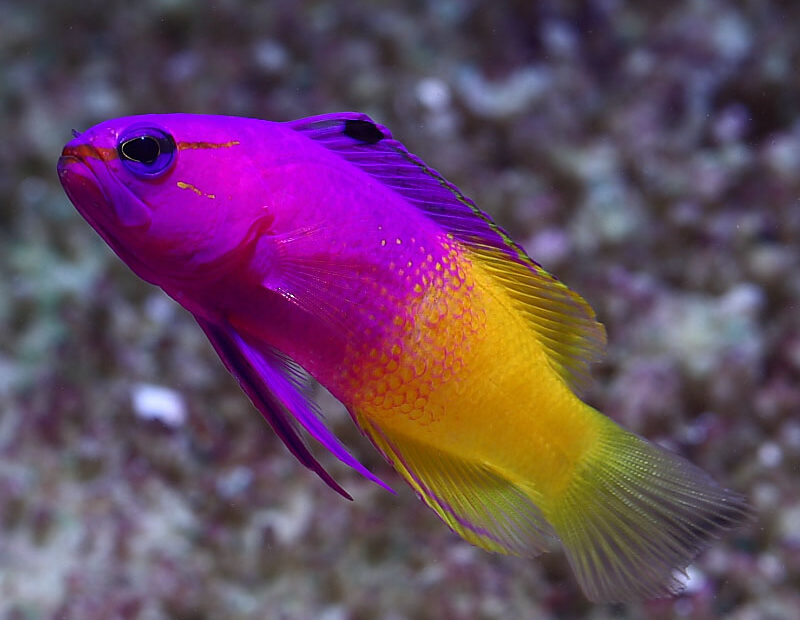Royal Gramma (Gramma loreto)
• Small fish safe: ✅ Yes
• Small invert safe: ✅ Yes
• Coral safe: ✅ Yes
• Minimum tank size: 75 liters (20 gallons)
• Adult size: Up to 8 cm (3 inches)
• Diet: Carnivorous, feeding on zooplankton and small invertebrates
• Be aware of: Can be territorial, especially in smaller tanks; requires caves or overhangs for shelter; generally peaceful but may defend its hiding spot
Appearance and Coloration
The Royal Gramma is one of the most strikingly colorful reef fish, featuring a vibrant purple front half that transitions into a golden-yellow rear. The transition between colors is smooth, creating a gradient effect. A distinct black marking on the dorsal fin and a black line through the eye add to its unique appearance.
This fish is not only beautiful but also hardy, making it a popular choice for both beginner and experienced aquarists.
Natural Habitat and Behavior
Gramma loreto is native to the Caribbean Sea, inhabiting coral reefs and rocky crevices at depths of 1 to 60 meters (3 to 200 feet). In the wild, it can often be seen hanging upside down under ledges, a behavior it continues in captivity.
Despite its generally peaceful nature, the Royal Gramma is territorial, especially toward fish that invade its preferred hiding spot. However, it is much less aggressive than similar-looking fish like Pseudochromis species (Dottybacks).
Tank Requirements and Water Parameters
• Minimum Tank Size: 20 gallons (75 liters) for a single fish; larger tanks (40+ gallons) recommended for multiple specimens.
• Water Parameters:
• Temperature: 24°C – 27°C (75°F – 81°F)
• pH: 8.1 – 8.4
• Specific Gravity: 1.020 – 1.025
• Aquascaping:
• Provide plenty of caves, ledges, and rock crevices for shelter.
• Ensure a mix of open swimming space and hiding spots to reduce stress.
• Lighting: Moderate to bright, mimicking natural reef conditions.
• Water Movement: Moderate flow, replicating their natural environment.
Diet and Feeding
Royal Grammas are carnivores, feeding primarily on zooplankton and small crustaceans in the wild. They are easy to feed in captivity, readily accepting a variety of frozen and prepared foods.
• Natural Diet: Zooplankton, copepods, and small invertebrates.
• Captive Diet:
• Mysis shrimp
• Brine shrimp
• Finely chopped seafood (shrimp, squid, fish)
• High-quality marine pellets and flakes
• Vitamin-enriched frozen foods
Feeding Frequency: 1-2 times per day to maintain health and vibrant coloration.
Compatibility and Social Structure
• Temperament:
• Peaceful toward most fish but territorial toward similar species.
• Will aggressively defend its cave or rock formation, especially in smaller tanks.
• Tank Mates:
• Compatible with clownfish, gobies, wrasses, and small reef-safe fish.
• Avoid housing with aggressive species, such as large dottybacks or large angelfish.
• Can be kept in pairs or small groups in larger tanks (40+ gallons) if introduced at the same time.
• Reef Compatibility: 100% reef-safe—does not harm corals or invertebrates.
Important Considerations
• Territoriality: Will defend a preferred cave or rock crevice, but aggression is minimal compared to dottybacks.
• Jumping Behavior: Moderate risk of jumping—ensure a secure lid to prevent escape.
• Hiding Behavior: Likes to hang upside down under ledges, which is normal and not a sign of illness.
